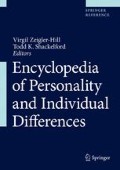Access this chapter
Tax calculation will be finalised at checkout
Purchases are for personal use only
References
Bernstein, E. M., & Putnam, F. W. (1986). Development, reliability, and validity of a dissociation scale. Journal of Nervous and Mental Disease, 174, 727–735.
Blizard, R. A. (1997). The origins of dissociative identity disorder from an object relations and attachment theory perspective. Dissociation, 10, 223–229.
Breuer, J., & Freud, S. (1893/1955). On the psychical mechanisms of hysterical phenomena: preliminary communication. In J. Strachey, The standard edition of the complete works of Sigmund Freud (Vol. II), pp. 3–17. London: The Hogarth Press.
Costa, R. M., Oliveira, T. F., Pestana, J., & Costa, D. (2016). Self-transcendence is related to higher female sexual responsiveness. Personality and Individual Differences, 96, 191–197.
Giesbrecht, T., Geraerts, E., & Merckelbach, H. (2007). Dissociation, memory commission errors, and heightened autonomic reactivity. Psychiatry Research, 150, 277–285.
McNally, R. J., Clancy, S. A., Schacter, D. L., & Pitman, R. K. (2000). Personality profiles, dissociation, and absorption in women reporting repressed, recovered, or continuous memories of childhood sexual abuse. Journal of Consulting and Clinical Psychology, 68, 1033–1037.
Ray, W. J., June, K., Turaj, K., & Lundy, K. (1992). Dissociative experiences in a college age population: a factor analytic study of two dissociation scales. Personality and Individual Differences, 13, 417–424.
Saucier, G., & Skraypinska, K. (2006). Spiritual but not religious? Evidence for two opposite dispositions. Journal of Personality, 74, 1257–1292.
Schore, A. N. (2009). Relational trauma and the developing right brain: an interface of psychoanalytic self psychology and neuroscience. Annals of the New York Academy of Sciences, 1159, 189–203.
van der Kruijs, S. J., Bodde, N. M., Carrette, E., Lazeron, R. H., Vonck, R. E., Boon, P. A., Langereis, G. R., Cluitman, P. J., Feijs, L. M., Hofman, P. A., Backes, W. J., & Aldenkamp, A. P. (2014). Neurophysiological correlates of dissociative symptoms. Journal of Neurology, Neurosurgery, and Psychiatry, 85, 174–179.
Author information
Authors and Affiliations
Corresponding author
Editor information
Editors and Affiliations
Section Editor information
Rights and permissions
Copyright information
© 2020 Springer Nature Switzerland AG
About this entry
Cite this entry
Costa, R.M. (2020). Dissociation (Defense Mechanism). In: Zeigler-Hill, V., Shackelford, T.K. (eds) Encyclopedia of Personality and Individual Differences. Springer, Cham. https://doi.org/10.1007/978-3-319-24612-3_1375
Download citation
DOI: https://doi.org/10.1007/978-3-319-24612-3_1375
Published:
Publisher Name: Springer, Cham
Print ISBN: 978-3-319-24610-9
Online ISBN: 978-3-319-24612-3
eBook Packages: Behavioral Science and PsychologyReference Module Humanities and Social SciencesReference Module Business, Economics and Social Sciences

